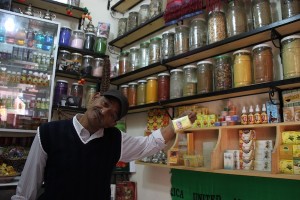Sightseeing in Morocco’s Marrakech had to include the souks, or open-air markets, many of them identified with specific goods, such as jewelry, carpets, spices and so forth.
The souks are a maze of narrow walking streets and alleyways that never head anywhere in a straight line, hugged on both sides by tiny or middling-sized open-front shops where merchants sometimes pitch their wares to passersby.
On a 2012 visit, I viewed an amazing array of colorful choices, but carpets remained my favorite.
The visuals were fascinating with lots of people walking about, some in traditional clothes, especially the women, some veiled. Also, some of Marrakech’s abundant cat population — apparently fed and more than tolerated by locals — made themselves comfortable in the shops.
My greatest fear was getting lost — or run over. There were no cars (no room) but guys on motor scooters roared about with seeming abandon.
My guided tour included a drive outside the walled center to the tanners’ souk, which is really an area where people work with leather. It’s a foul place where processing leather means soaking it in vats of urine. We did not linger.
Next day, I returned alone to the souks but I was never sure I would make my goal; nothing in the souk area matched anything I saw on my map.
In broken French, I asked many for directions; they (always men, usually merchants) were invariably helpful. I did make my goal, the Ben Youssef madrasah.
I also blew off my last Moroccan coins on a piece of Tuareg jewelry. The Tuareg are a Berber-speaking, generally nomadic Saharan people. Tuareg men are called “blue men of the Sahara” because their hand-dyed blue veils stain the skin.
My merchant, a Tuareg himself, wrapped my head in his scarf, handed me a gun and — with my camera — took photos of me in this nutty get-up.
My newfound friend, who didn’t look especially blue, insisted I meet another Tuareg who sold spices and scents at an establishment called the Berber Apothecary. I said, “Two minutes only.”
It wasn’t two minutes, but this merchant, who spoke incredibly fast in English, was quite entertaining when talking about the spices and scents. If I had still had Moroccan currency in my pocket, I would have bought something in gratitude for the show. I don’t remember a thing he said.

The author, Nadine Godwin, imitating a Tuareg (up to a point) in a photo taken by a Tuareg merchant in the Marrakech souks.
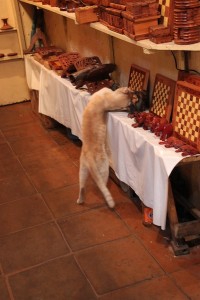
A cat claims its space by rubbing its head over some of the goods in a shop found in the Marrakech souks.
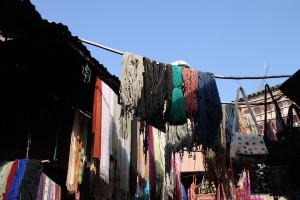
Colorfully dyed yarns hanging over the narrow streets of the Marrakech dyers’ souk, along with other goods also available for sale.
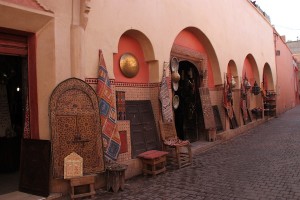
Carpets and other Moroccan goods artfully displayed in the souks of Marrakech. Carpets remain my favorite.
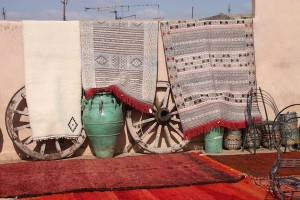
Carpet display on the roof of a huge shop selling carpets and a wide range of other Moroccan products, in Marrakech. These are seen at a shop called Twizra, which is not in the souks, but I like the carpets and the photo!
For more about Morocco, we offer at BestTripChoices.com the following, under the headline: American connections https://besttripchoices.com/international-countries/morocco/
This blog and all but one of the photos are by Nadine Godwin, BestTripChoices.com editorial director and contributor to the trade newspaper, Travel Weekly. She also is the author of “Travia: The Ultimate Book of Travel Trivia.”

